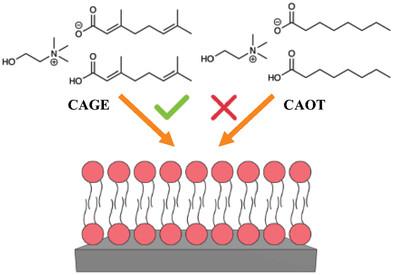当前位置:
X-MOL 学术
›
Adv. Funct. Mater.
›
论文详情
Our official English website, www.x-mol.net, welcomes your
feedback! (Note: you will need to create a separate account there.)
Interactions of Choline and Geranate (CAGE) and Choline Octanoate (CAOT) Deep Eutectic Solvents with Lipid Bilayers
Advanced Functional Materials ( IF 18.5 ) Pub Date : 2023-10-02 , DOI: 10.1002/adfm.202306644 George M. Neville 1 , Ana‐Maria Dobre 2 , Gavin J. Smith 2 , Samantha Micciulla 3, 4 , Nick J. Brooks 2 , Thomas Arnold 5, 6, 7 , Tom Welton 2 , Karen J. Edler 1, 8
Advanced Functional Materials ( IF 18.5 ) Pub Date : 2023-10-02 , DOI: 10.1002/adfm.202306644 George M. Neville 1 , Ana‐Maria Dobre 2 , Gavin J. Smith 2 , Samantha Micciulla 3, 4 , Nick J. Brooks 2 , Thomas Arnold 5, 6, 7 , Tom Welton 2 , Karen J. Edler 1, 8
Affiliation

|
Mixtures between choline and geranic acid (CAGE) have previously been shown to insert into lipid bilayers. This may be useful for the transdermal delivery of larger pharmaceuticals, however, little is known about the mechanism of activity. By comparing the interactions between CAGE and lipid bilayers with those of a less-active, yet closely-related analogue, choline octanoic acid (CAOT), a chemical basis can be investigated. Overall, six systems are studied here by neutron reflectivity, where d54-1,2-dimyristoyl-sn-glycero-3-phosphocholine (DMPC) solid-supported phospholipid bilayers are first formed on SiO2 substrates before exposure to the deep eutectic solvent (DES). Components of the DES could be identified within the bilayer by exploiting contrast variation and selective deuteration. CAGE is shown to be a mild disruptive agent, free to insert and diffuse across the bilayer, preserving much of the bilayer integrity. Experiments identify co-mingling of geranate ions inhibits the efficient packing of lipid tails, increasing hydration across the bilayer. Conversely, CAOT is found to both exchange and remove lipid molecules to achieve incorporation, inducing swelling and the formation of solvent patches. It appears these behaviors derive from the structures of the anions and thus amphiphilicity of the DES, laying the foundations for the rational design and optimization of these candidates toward transdermal delivery.
中文翻译:

胆碱和香叶酸 (CAGE) 和辛酸胆碱 (CAOT) 低共熔溶剂与脂质双层的相互作用
胆碱和香叶酸 (CAGE) 的混合物先前已被证明可以插入脂质双层中。这对于较大药物的透皮递送可能有用,但是,人们对其活性机制知之甚少。通过比较 CAGE 和脂质双层与活性较低但密切相关的类似物辛酸胆碱 (CAOT) 之间的相互作用,可以研究化学基础。总的来说,这里通过中子反射率研究了六个系统,其中 d 54 -1,2-二肉豆蔻酰-sn-甘油-3-磷酸胆碱 (DMPC) 固体支撑的磷脂双层首先在 SiO 2基底上形成,然后暴露于低共熔溶剂中(DES)。通过利用对比度变化和选择性氘化,可以在双层内识别 DES 的成分。CAGE 被证明是一种温和的破坏剂,可以自由插入并扩散到双层,从而保留双层的大部分完整性。实验发现香叶酸盐离子的混合会抑制脂质尾部的有效堆积,从而增加双层的水合作用。相反,CAOT 可以交换和去除脂质分子以实现掺入,诱导膨胀和溶剂斑块的形成。这些行为似乎源自阴离子的结构以及 DES 的两亲性,为合理设计和优化这些候选药物的透皮递送奠定了基础。
更新日期:2023-10-02
中文翻译:

胆碱和香叶酸 (CAGE) 和辛酸胆碱 (CAOT) 低共熔溶剂与脂质双层的相互作用
胆碱和香叶酸 (CAGE) 的混合物先前已被证明可以插入脂质双层中。这对于较大药物的透皮递送可能有用,但是,人们对其活性机制知之甚少。通过比较 CAGE 和脂质双层与活性较低但密切相关的类似物辛酸胆碱 (CAOT) 之间的相互作用,可以研究化学基础。总的来说,这里通过中子反射率研究了六个系统,其中 d 54 -1,2-二肉豆蔻酰-sn-甘油-3-磷酸胆碱 (DMPC) 固体支撑的磷脂双层首先在 SiO 2基底上形成,然后暴露于低共熔溶剂中(DES)。通过利用对比度变化和选择性氘化,可以在双层内识别 DES 的成分。CAGE 被证明是一种温和的破坏剂,可以自由插入并扩散到双层,从而保留双层的大部分完整性。实验发现香叶酸盐离子的混合会抑制脂质尾部的有效堆积,从而增加双层的水合作用。相反,CAOT 可以交换和去除脂质分子以实现掺入,诱导膨胀和溶剂斑块的形成。这些行为似乎源自阴离子的结构以及 DES 的两亲性,为合理设计和优化这些候选药物的透皮递送奠定了基础。


















































 京公网安备 11010802027423号
京公网安备 11010802027423号